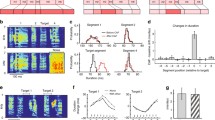Abstract
We present an artificial neural network used to learn online complex temporal sequences of gestures to a robot. The system is based on a simple temporal sequences learning architecture, neurobiological inspired model using some of the properties of the cerebellum and the hippocampus, plus a diversity generator composed of CTRNN oscillators. The use of oscillators allows to remove the ambiguity of complex sequences. The associations with oscillators allow to build an internal state to disambiguate the observable state. To understand the effect of this learning mechanism, we compare the performance of (i) our model with (ii) simple sequence learning model and with (iii) the simple sequence learning model plus a competitive mechanism between inputs and oscillators. Finally, we present an experiment showing a AIBO robot, which learns and reproduces a sequence of gestures.
Preview
Unable to display preview. Download preview PDF.
Similar content being viewed by others
References
Molter, C., Salihoglu, U., Bersini, H.: Learning cycles brings chaos in continuous hopfield networks. In: IJCNN. Proceedings of the International Joint Conference on Neural Networks conference (2005)
Daucé, E., Quoy, M., Doyon, B.: Resonant spatio-temporal learning in large random neural networks. Biological Cybernetics 87, 185–198 (2002)
Jaeger, H.: Short term memory in echo state networks. Technical Report GMD Report 152, German National Research Center for Information Technology (2001)
Jaeger, H.: The ”echo state” approach to analysing and training recurrent neural networks. Technical Report GMD Report 148, German National Research Center for Information Technology (2001)
Ijspeert, A.J., Nakanishi, J., Shibata, T., Schaal, S.: Nonlinear dynamical systems for imitation with humanoid robots. In: Humanoids2001. Proceedings of the IEEE/RAS International Conference on Humanoids Robots, pp. 219–226 (2001)
Calinon, S., Billard, A.: Learning of Gestures by Imitation in a Humanoid Robot. In: dautenhahn, K., nehaniv, c.l. (eds.) Cambridge University Press, Cambridge (in press)
Hersch, M., Billard, A.: A biologically-inspired model of reaching movements. In: Proceedings of the 2006 IEEE/RAS-EMBS International Conference on Biomedical Robotics and Biomechatronics, Pisa (2006)
Bullock, D., Grossberg, S.: Neural dynamics of planned arm movements: Emergent invariants and speed-accuracy properties during trajectory formation. Psychological Review 95, 49–90 (1988)
Ans, B., Coiton, Y., Gilhodes, J.C., Velay, J.L.: A neural network model for temporal sequence learning and motor programming. Neural Networks 7(9), 1461–1476 (1994)
Gaussier, P., Moga, S., Banquet, J.P., Quoy, M.: From perception-action loops to imitation processes. Applied Artificial Intelligence (AAI) 1(7), 701–727 (1998)
Ijspeert, A.J.: A neuromechanical investigation of salamander locomotion. In: AMAM 2000. Proceedings of the International Symposium on Adaptive Motion of Animals and Machines (2000)
Yamauchi, B., Beer, R.D.: Sequential behaviour and learning in evolved dynamical neural networks. Adapt. Behav. 2(3), 219–246 (1994)
Andry, P., Gaussier, P., Nadel, J., Hirsbrunner, B.: Learning invariant sensorimotor behaviors: A developmental approach to imitation mechanisms. Adaptive behavior 12(2), 117–138 (2004)
Author information
Authors and Affiliations
Editor information
Rights and permissions
Copyright information
© 2007 Springer-Verlag Berlin Heidelberg
About this paper
Cite this paper
Lagarde, M., Andry, P., Gaussier, P. (2007). The Role of Internal Oscillators for the One-Shot Learning of Complex Temporal Sequences. In: de Sá, J.M., Alexandre, L.A., Duch, W., Mandic, D. (eds) Artificial Neural Networks – ICANN 2007. ICANN 2007. Lecture Notes in Computer Science, vol 4668. Springer, Berlin, Heidelberg. https://doi.org/10.1007/978-3-540-74690-4_95
Download citation
DOI: https://doi.org/10.1007/978-3-540-74690-4_95
Publisher Name: Springer, Berlin, Heidelberg
Print ISBN: 978-3-540-74689-8
Online ISBN: 978-3-540-74690-4
eBook Packages: Computer ScienceComputer Science (R0)




